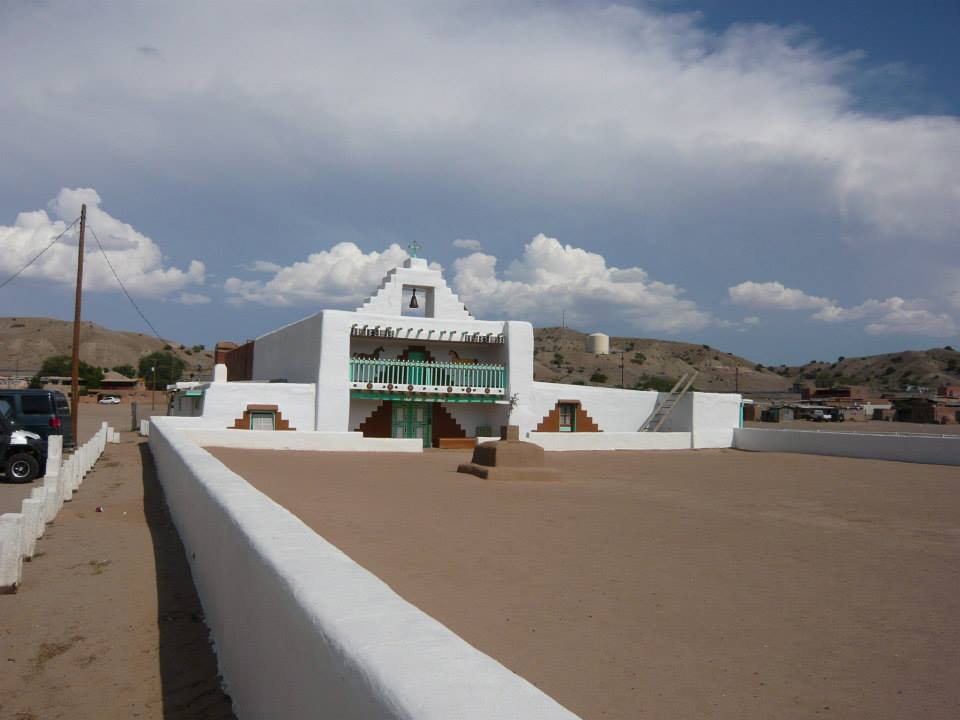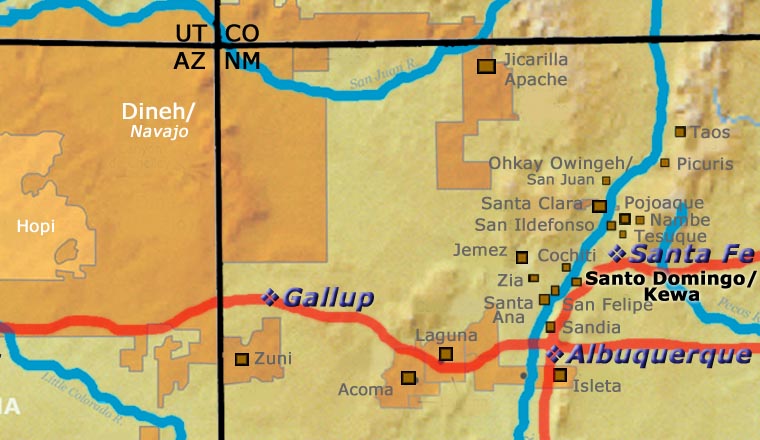
William Pacheco
Santo Domingo

William Andrew Pacheco was born in mid-October, 1975, to Gilbert and Paulita Pacheco of Santo Domingo Pueblo, both potters. Like a typical 10 year old boy, he was truly in love with dinosaurs, allosaurs in particular, with long necks, big legs, droopy stomachs and long tails.
He first put his hands in the clay with the intent to make a real pot when he was fifteen. He told us his primary teachers were his father, Gilbert, and his uncle, Robert Tenorio. Rose and Ione Pacheco, also potters, were in the family, too. But when it came time to make his own pottery, what stirred William's heart was open bowl forms decorated on the outside with dinosaurs. The next year, 1991, he was accepted as an exhibitor at the 19th Annual American Indian Festival & Market of the Natural History Museum of Los Angeles County, in California. Before he was 18, he won the Best of Division ribbon in the Youth category at the Santa Fe Indian Market. Those early pieces were signed "Andrew Pacheco" Unlike Peter Pan, William grew up, went to Harvard, and stopped making pots, and Andrew became William.
William majored in East Indian studies as an undergrad and chose Japanese to fulfill his language requirement. He made numerous trips to Japan. He studied Japanese ceramics. He also developed an exchange student program between Harvard and several Japanese schools. It became so popular that Tibet and Indonesia were added. In the fall of 2023, he went back to school and became a graduate student in the Educational Learning Design program at Harvard, which he will finish this summer (2023). Then, he's off to MIT to do research on saving indigenous languages.
When he wants to relax, though, he said he comes back to making pottery. It brings a calm and peaceful creative outlet to his life. When we asked him what he likes to do for fun, other than make pottery, he replied, "I love to travel, and learn new languages. I'm just back from a long stay in Bali. I learned about the culture and the art, and learned to speak Indonesian. But, I also speak Keres at home and some Tibetan. When I was studying in France I had to learn French. That language was the hardest one for me."
100 West San Francisco Street, Santa Fe, New Mexico 87501
(505) 986-1234 - www.andreafisherpottery.com - All Rights Reserved

Santo Domingo Pueblo

Santo Domingo Pueblo Mission Church
Santo Domingo Pueblo is located on the east bank of the Rio Grande about half-way between Santa Fe and Albuquerque. Historically, the people of Santo Domingo were among the most active of Pueblo traders. The pueblo also has a reputation of being ultra traditional, probably due, at least in part, to the longevity of the pueblo's pottery styles. Some of today's popular designs have changed very little since the 1700s.
In pre-Columbian times, traders from Santo Domingo were trading turquoise (from mines in the Cerrillos Hills) and hand-made heishe beads as far away as central Mexico. Many artisans in the pueblo still work in the old ways and produce wonderful silver and turquoise jewelry and heishe decorations.
Like the people of nearby San Felipe and Cochiti, the people of Santo Domingo speak Keres and trace their ancestry back to villages established in the Pajarito Plateau area in the 1400's. Like the other Rio Grande pueblos, Santo Domingo rose up against the Spanish oppressors in 1680, following Alonzo Catiti as he led the Keres-speaking pueblos and worked with Popé (of San Juan Pueblo) to stop the Spanish atrocities. However, when Spanish Governor Antonio Otermin returned to the area in 1681, he found Santo Domingo deserted and ordered it burned. The pueblo residents had fled to a nearby mountain stronghold and when Don Diego de Vargas returned to Nuevo Mexico in 1692, he attacked that mountain fortress and burned it, too. Catiti died in that battle and Keres opposition to the Spanish crumbled with his death. The survivors of that battle fled, some to Acoma, some to fledgling Laguna, some to the Hopi mesas. Over time most of them returned to Santo Domingo.
In the 1790s Santo Domingo accepted an influx of refugees from the Galisteo Basin area as they fled the near-constant attacks of Apache, Comanche, Ute and Navajo raiders in that area. Today's main Santo Domingo village was founded about 1886.
In 1598 Santo Domingo was the site of the first gathering of 38 pueblo governors by Don Juan de Oñaté to try to force them to swear allegiance to the crown of Spain. Today, the All Indian Pueblo Council (consisting of the nineteen remaining pueblo's governors and an executive staff) gathers at Santo Domingo for their first meeting every year, to continue what is now the oldest annual political gathering in America. During the time of the Spanish occupation Santo Domingo served as the headquarters of the Franciscan missionaries in New Mexico and religious trials were held there during the Spanish Inquisition.
Today, the people of Santo Domingo number around 4,500, with about two-thirds of them living on the reservation. The pottery traditions of the pueblo almost died out after the railroads arrived and many Santo Domingos went to work laying tracks. Even today many Santo Domingo men work as firefighters for the US Forest Service in fire season and ply their artistic talents during the rest of the year.
Potter Robert Tenorio began working to revive the Santo Domingo pottery tradition in the early 1970s. His influence can be found among many of today's Santo Domingo potters, even if they say he stimulated them to learn on their own.
While today's Santo Domingo pottery is known for designs described as simple geometrics, another outstanding feature is boldness: the lines are thick and well-defined.
As religious leaders forbid the representation of human figures as well as other sacred designs on pottery made for commercial purposes, birds, fish and flowers are common design motifs. Depictions of mammals are rarely seen. Another typical Santo Domingo style is to paint in the negative, meaning cover the pot in panels of big swatches of black and red so that only a few lines of the cream slip show through.
100 West San Francisco Street, Santa Fe, New Mexico 87501
(505) 986-1234 - www.andreafisherpottery.com - All Rights Reserved

Tenorio Family Tree
Disclaimer: This "family tree" is a best effort on our part to determine who the potters are in this family and arrange them in a generational order. The general information available is questionable so we have tried to show each of these diagrams to living members of each family to get their input and approval, too. This diagram is subject to change should we get better info.
-
Clemente & Nescita Calabaza (maternal side) & Andrea Ortiz (paternal side)
- Juanita Calabaza Tenorio (1922-1982) & Andres Tenorio
- Mary Edna Coriz (1946-) & Luciano Coriz
- Angel Bailon (1968-) & Ralph Bailon
- Paulita Pacheco (1943-2008) & Gilbert Pacheco (1940-2010)
- Andrew Pacheco (1975-)
- Rose Pacheco (1968-) & Billy Veale (Navajo)
- Robert Tenorio (1950-)
Among Robert's students:
- Ambrose Atencio
- Corine Lovato
- Hilda Coriz (1949-2007) & Arthur Coriz (1948-1999)
- Ione Coriz (1973-)
- Warren Coriz (1966-2011)
- Mary Edna Coriz (1946-) & Luciano Coriz
-
Gilbert Pacheco's sisters who became potters:
- Laurencita Calabaza
- Santana Calabaza
- Trinidad Pacheco
- Vivian Sanchez
- Laurencita Calabaza
Some of the above info is drawn from Southern Pueblo Pottery, 2000 Artist Biographies, by Gregory Schaaf, © 2002, Center for Indigenous Arts & Studies
Other info is derived from personal contacts with family members and through interminable searches of the Internet and cross-examination of the data found.
(505) 986-1234 - www.andreafisherpottery.com - All Rights Reserved
